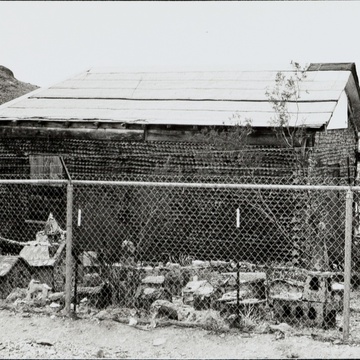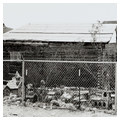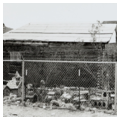Though deteriorated, this three-room, one-story structure is the finest remaining example of a bottle house in Nevada. It was erected by Tom Kelly, an Australian-born stonemason. Kelly used about 20,000 beer bottles, along with some medicine bottles. Because of their fragile construction and attraction for bottle collectors, few such houses have survived in the United States.
The building's plan is L-shaped, with a gable roof and eclectic details on the porch and gable ends. Bottles make up the foundation and walls, laid in regular courses, bottoms to the exterior. Adobe mortar holds the bottles together. Kelly differentiated the foundation from the walls by
Paramount Pictures used the building in the 1920s as a set for a western film, Wanderer of the Wasteland. Since then, the building has deteriorated, though various owners inhabited the dwelling until the 1980s. The on-and-off operation of nearby mines during the twentieth century has posed the greatest danger to the survival of the house and to Rhyolite's ruins. In addition, the difficulty of affixing the adobe to the smooth surfaces of the bottles has remained a problem in stabilizing the house. The Bureau of Land Management, which now manages the property, has worked diligently with a local preservation group to keep the house standing.
A favorite of locals and tourists alike, the bottle house has inspired others to use glass to create their own objects. A wishing well and miniature village comprising about thirty-six structures made of glass, ceramic fragments, and bottlecaps stand near the house. Tommy Thompson, a former resident of the house, created the folk-art village from the 1950s to the 1970s.




